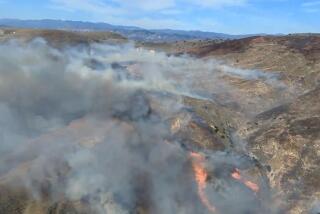Hundreds flee as wind drives flames through Griffith Park
Firefighters struggled Tuesday night to contain wind-whipped flames that scorched hundreds of acres in Griffith Park, forced the evacuation of some of Los Angeles’ best-known landmarks and raced toward hillside homes in Los Feliz, prompting a hasty evacuation.
The fire was the park’s worst in at least three decades and was the latest of several to strike the Hollywood Hills in what has been the driest year on record.
The Observatory, Greek Theatre, Los Angeles Zoo, Travel Town and Museum of the American West, as well as nearby golf courses, a magnet school and boys camp were evacuated Tuesday afternoon as firefighters dealt with erratic winds and bone-dry brush that has received less than 4 inches of rain in the last year.
Officials had expected that as night fell, moist air would flow in from the ocean, aiding their efforts. Instead, the hot winds continued, shifted direction and sent flames south toward the upscale homes in the hills above Los Feliz Boulevard.
At an 11 p.m. news conference, officials said 600 acres had burned. No containment was in sight.
Los Angeles Mayor Antonio Villaraigosa said that there were “no facts to indicate that this is an arson fire ... it could be an accident.”
Fire officials said late Tuesday that the cause remains under investigation. Police said that a man, believed to be about 20 years of age, was burned in the fire and was detained and cited on suspicion of smoking in a restricted area, which would be a misdemeanor. Officials would not say, however, if they believed that incident sparked the fire.
The man was listed in stable condition at the Grossman Burn Center at Sherman Oaks Hospital.
The evacuation was ordered for a neighborhood southeast of the park that extended, by late in the night, down to Los Feliz Boulevard. By 10 p.m., about 300 people had been evacuated, but Los Angeles officials said 25 refused to leave, prompting urgent calls from authorities for residents to cooperate.
“It just exploded,” said Michael Widman, 46, who lives on Commonwealth Avenue and was packing up pictures and computers as he prepared to evacuate. “I don’t see how they’re going to knock it down. It’s a shame.”
Police and firefighters were knocking on doors Tuesday night along Dundee Drive, crowded with police vehicles and firetrucks, looking for stragglers hesitant to leave their homes. They escorted one elderly couple out of their house and loaded them into a police SUV.
“Come on, come on, you got to go,” authorities said as they walked up and down the street.
Karl Amlauer, 81, who has lived on nearby Dundee Drive for 46 years, said this is the first time he has had to evacuate. He, like Widman, said the fire had been calm and suddenly began to rage.
“It happened so fast,” Amlauer said. “I thought it was almost over and all of a sudden here it is.”
Amlauer and his wife were loading up their BMW hatchback with pictures, antique clocks and clothes.
“You can’t take everything,” he said.
The fire prompted Los Angeles Zoo officials to activate their emergency plan. The fire also threatened the park’s historic merry-go-round and sent scores of visitors fleeing.
“It was red as hell,” Councilman Tom LaBonge said of the blaze. Before leaving the fire command center Tuesday night, LaBonge called it probably the park’s worst fire since 1961. “It’s bad,” he said. “Nothing is stopping it.”
Late Tuesday, LaBonge said that Dante’s View, a popular hiking destination in the park, was destroyed.
The fire was the fifth in the 4,200-acre park since December and one of a string of blazes to hit the Hollywood Hills. In March, a fire crept up the hills on the San Fernando Valley side and burned near the Hollywood sign. Earlier this year, brush fires destroyed homes in Malibu and Beverly Hills.
Downtown Los Angeles is close to setting a record for lack of rainfall. County officials issued a report earlier this week that found the moisture level of hillside brush was 50% lower this May than a year earlier. The brush is expected to dry considerably more during the summer and early fall.
About 500 fire personnel were on the scene and water was being dropped by five Los Angeles County firefighting helicopters. They were aided by two aircraft from the state, which dumped thousands of gallons of fire retardant on vegetation that had not yet burned.
“We had swirling winds for most of the day and it just wreaked havoc,” said Deputy Fire Chief Mario Rueda of the Los Angeles City Fire Department.
Zookeepers, grounds and maintenance crews, public safety officers and the zoo director remained on the grounds to keep watch over the animals and the premises.
“So far the animals are faring fine,” said Jason Jacobs, director of marketing and public relations for the zoo. “I haven’t heard any reports of anything going wrong.”
A disaster response team with the Society for the Prevention of Cruelty to Animals rolled up near the entrance to the zoo, preparing for a possible evacuation. The team brought a horse trailer and a utility trailer equipped with nets and tranquilizer guns.
SPCA Capt. Dave Havard, who had a crew of half a dozen, said they could take small birds and other animals no bigger than a llama or an emu. He said that the birds were most susceptible to the smoke and that moving any of the larger animals would be difficult.
“It’s not like they can pull a lot of animals from there unless they have big equipment,” he said, as helicopters bombarded flames in the hillsides. “Big cats, elephants, all these big guys, they’re going to have to have a plan to handle that.”
Zoo Director John Lewis said that winds were keeping banks of orange and white smoke away from the complex. He said that most of the zoo’s 1,200 animals were put inside holding quarters and that staff was monitoring them.
The fire frightened park visitors enjoying what had been a sunny, if unseasonably warm, spring day.
Chris Kruells, 52, a retired municipal worker and a regular park visitor, was eating lunch near the merry-go-round about 2 p.m. when he heard fire officials on loudspeakers telling people to leave. He looked up to see towering flames in the hills.
“It was like a tornado,” he said. “It was spinning, you know like one of those eddies.”
Greg Shields, 45, saw smoke from his home in Los Feliz and biked into the park. He watched as firefighters tried to knock back flames that seemed unpredictable.
“Occasionally you’d see it flame up 40 feet, then die, then start up again,” he said. “It depended on the fuel that was up there.”
At one point, several firefighters were caught near a footbridge as the fire raged through a canyon. The fire jumped over the bridge and raced toward them, but a water-dropping helicopter was able to douse the flames before anyone was injured.
The fire started after 1 p.m. in Aberdeen Canyon, northeast of the Roosevelt Golf Course on the park’s southern edge, near the Greek Theatre.
Rueda, of the Fire Department, said the work of firefighters was made more difficult by hot whirling winds and the hilly terrain.
To the east of the command post at Greek Theatre, the afternoon sky was blue. To the west, large plumes of light brown smoke filled the air and appeared to be floating toward downtown Los Angeles.
The winds around the park were “horrible weather” for battling the blaze, said firefighter David Schaefer. “It jumped multiple ridges, it jumped through multiple canyons.”
An unofficial evacuation of the Griffith Observatory began about 3:30 p.m., in part out of concern that the fire would force officials to cut off shuttle services to the facility. With yellow and orange flames on the horizon, visitors packed on shuttle buses and made their way down the hill. Water-dropping county fire helicopters darted overhead as visitors made their way to the shuttle buses.
Griffith Park has suffered devastating fires in the past, including an October 1933 brush fire believed to have killed more firefighters -- 29 -- than any wildfire in the nation’s history. More than 150 others were hurt.
The victims were among the more than 3,000 Depression-era workers from the Civilian Conservation Corps and Works Progress Administration, armed with shovels and pickaxes, who were brought in to battle the blaze.
In the Inland Empire, the high temperatures and red flag conditions contributed to blazes in San Bernardino and Corona.
A fire that started shortly after 5 p.m. Tuesday in San Bernardino’s Blair Park raced through 300 acres on Little Mountain.
The fire threatened 60 to 70 homes, coming close enough to one residential complex to burn a shed and part of a roof of a home on Beverly Drive. One firefighter received medical treatment after reporting a back injury.
Voluntary evacuations for the families living around the base of Little Mountain were lifted shortly after 8 p.m., San Bernardino City Fire spokesman Mike Arvizo said.
“It went really fast -- wrapping around both sides of the mountain,” Arvizo said in an interview about 8:30 p.m. “But everybody is back home now.”
And in Riverside County, firefighters were battling a fire that began about 5 p.m. in El Cerrito south of Corona, but no structures were threatened. More than 160 firefighters were on the scene, and some 600 acres apparently had burned by 10 p.m. A civilian was treated for heat-related injuries and released at the scene. Firefighters expected to be able to contain the fire by 6 p.m. today.
*
ron.lin@latimes.com
paul.pringle@latimes.com
Times staff writers Andrew Blankstein, Amanda Covarrubias, Megan Garvey, Larry Gordon, Efrain Hernandez Jr., J. Michael Kennedy, Maeve Reston, Ted Rohrlich, Stuart Silverstein and Richard Winton contributed to this report.
More to Read
Start your day right
Sign up for Essential California for news, features and recommendations from the L.A. Times and beyond in your inbox six days a week.
You may occasionally receive promotional content from the Los Angeles Times.







